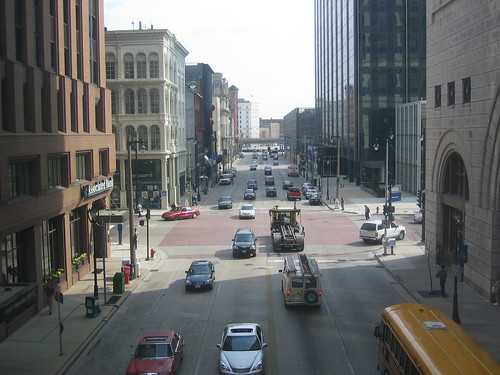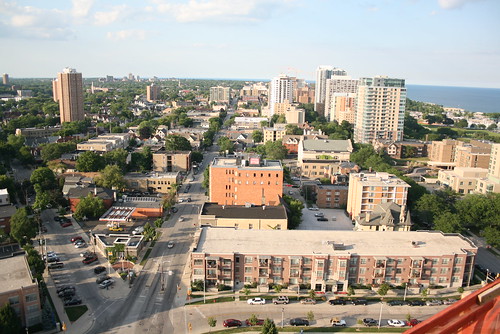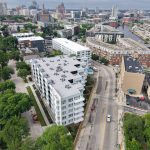Does Downtown Milwaukee Need More Street Trees?
Ask yourself what’s missing along most of Wisconsin Avenue as it crosses through downtown.
Then take a look at Milwaukee’s lower east side.
The biggest difference? The trees. The trees that cover the lower east side give it a sense of place, despite being just north of downtown. Despite sporting the highest population density in Wisconsin for a neighborhood, the lower east side seems calm, manageable, and cool (thanks to the shade provided by the trees).
Trees also have a large number of other effects.
Trees Increase Revenues
Merchants often oppose tree planting programs, fearing their signs or windows will be blocked from view. Careful species selection and trimming can maintain views and overcome these objections. But is it worth the effort? One study [3] found customers not only prefer shopping districts with trees, but are willing to pay more for products purchased there. Specifically, the study found:
- Customers traveled longer, farther, and more often to tree-enhanced shopping districts. The stayed longer, and were willing to pay more for both products and parking.
- Participants rated “Amenity and Comfort” of tree-lined sidewalks about 80% higher compared to non-shaded streets. Also, “Quality of Product” ratings were 30% higher in districts having trees, and customer service was considered better on these streets.
- When asked to estimate a price for each of 15 items in a “basket of goods,” participants consistently priced goods significantly higher in districts with trees. It did not matter what type or price range of products were being sold.
- Merchants also showed a general preference for trees, but they consistently underestimated the effect of trees on customer behavior and buying decisions.
So with numerous retail locations empty along Wisconsin Avenue and even more underdeveloped properties located just off the grand avenue, wouldn’t adding more trees be the equivalent of picking the low-lying fruit? This isn’t to say that the core of downtown Milwaukee is completely barren, some properties are wonderfully streetscaped, but the vast majority are concrete heat islands.
To any naysayer that claims adding trees would eat needed sidewalk space, I challenge them to stand on almost any downtown street during a weekday and count how many times they had to get out of the way because the sidewalk was entirely full. They wouldn’t need to use their toes to count, and would be lucky to almost run out of fingers.
The answer to the title of this blog post is yes. Adding more street trees to downtown Milwaukee is a no brainer. It would be a cheap and easy way to improve the business climate, encourage further use of the park once concept, and a good way to make the area more attractive to potential residents.






















It would seem that the perfect compromise is obvious: artificial trees.
They:
– can provide the aesthetic advantage;
– could be crafted to the perfect size and shape so as to not interfere with merchants’ storefronts;
– will need little to no maintenance, compared to organic trees;
– don’t allow invasive species like the ash borer to proliferate;
– can’t carry diseases like Dutch Elm; and
– won’t die.
Further, they could be manufactured with recycled plastics, and embedded with a conductive, grounded “trunk” that would act as lightning rods, protecting nearby structures. This would also make it unlikely that thick, heavy branches would be knocked off in storms crushing parked cars.
It works for Disneyworld…
-jjg
DailyScoff.com
@JJG
Interesting idea, something I honestly hadn’t considered. Isn’t it going to be a little odd in the winter with fully leaved, green trees lining streets? We have to replace them every few years right when they get faded in the sun? I don’t know that they’ll be tall enough to protect nearby structures, but that certainly is an interesting idea.
I also wonder what kind of environmental impact real trees would have on the surrounding area. Would they suck up a measurable amount of carbon?
Do birds like artificial trees? As much as they like real trees? While bird poop certainly isn’t fun, it’s probably not a bad thing to restore some natural habitat to downtown Milwaukee. Might somehow chase away massiave amounts of seagulls if we’re lucky.
Thanks for the comment. Interesting idea.
@JJG Funny
@JJG
You’re a moron. Some serious comments would be appreciated instead of your sarcasm.
And your solution iiiiiiis…?
Mine is a practical suggestion that doesn’t compromise the integrity of the underground utilities with invasive roots, nor burden the streets and sanitation departments with pruning, raking, leaf collection, or insect control. Further, it would allow recyclers to transform plastic garbage into beautiful, natural-appearing, landscape adorning, clean, huggable trees.
Besides, it would go against the nature of my character to be sarcastic.
Sardonic, perhaps. But never sarcastic…
-jjg
DailyScoff.com
@JJG
Your solution isn’t practical, it’s ridiculous. Sorry, but installing hundreds of fake trees is only going to get us featured in the “strange but true” section of newspapers everytime it snows. The pictures will be beautiful.
We can recycle our plastics many other ways than into fake trees.
As far as the root structure, there are already trees downtown and the power and telephone lines don’t randomly go off as the tree goes, so clearly it’s not an issue.
“In fact, over time, aggressive root systems can cause serious damage to landscape structures and utilities, most importantly our homes, and the problem can be extremely difficult and expensive to correct.”
Source: http://www.northscaping.com/InfoZone/IS-0129/IS-0129.shtml
Bottom line, organic trees are costly and bad for the urban environment. Outdoor artificial trees are a welcome alternative, providing shade, character, and aesthetic improvement in an economical and environmentally responsible manner…
-jjg
DailyScoff.com
Artificial trees? Holy God no. It blows my mind anyone would even consider that. No trees is better than fake trees.
Still, I don’t think it’s such a huge issue given how little space there is for street trees downtown, but it would be nice to put some trees where space allows, or on parking lots.
@Toxy agreed the plastic trees thing is silly.
But downtown Milwaukee has plenty of room for true street trees. To me a street that could be dramatically improved is Broadway. That said the issue with Broadway that for a large part it has hollow walks so I’d actually suggest using trees in the middle of the street (once it is made two-ways) much like in Pioneer Square in Seattle. It could change Broadway for the better.
Silly how? I’ve heard nothing but ridicule of the proposal as “silly” and “impractical” yet I’ve been able to thoroughly substantiate it as feasible and responsible, both environmentally and economically.
Surely there’s room for compromise between “no trees” and “trees”. Given its attractiveness, utility, and affordability, foliage made from recyclables seems to be the most reasonable middle-ground…
-jjg
DailyScoff.com
I guess I don’t particularily think that Wisconsin Avenue needs more trees. It appears as there aren’t very many at this point because the new streetscaping has yet to grow into trees of an appreciable size. I feel that once these grow a bit, it will really green up the street. The streetscaping is some of my favorite pockets of greenery in downtown.
However, I would agree that many of the other roads in the downtown area need a lot more greenery. Even Kilbourn Avenue from the River to the Courthouse, which has that wide boulevard feel, is a bit of a concrete jungle.
@Kevin
Yeah, I think you’re possibly on to something with the “let them grow” idea. I think some areas in West Town still feel rather barren. Kilbourn Avenue is certainly one of them. I think the mass of government buildings and convention/event buildings adds to that.
There are certainly areas in East Town too. Broadway as Dave pointed out is lacking in certain areas.
@J Gravelle
There won’t be fake trees all over, sorry. They’re not attractive in the winter when they’re green. It may be responsible to some extent environmentally in a world where a tree is not an option, but as the rest of Milwaukee has proven trees are an option. They line streets and sidewalks and utility lines aren’t damaged, it appears the DPW knows how to pick the ones with better root structures.
There won’t be fake trees in Milwaukee, it’s a ridiculous idea because of their visual appearance in the winter alone.
I agree more trees along pedestrian and oft-traveled arteries downtown have a progressive (de-industrializing), aesthetic appeal. Having more trees downtown and it’s adjacent, dense residential areas makes sense as it would compliment the natural appeal of the lake as well. I am not implying that I’d walk down every street “hugging” each tree for their environmental appeal, it just makes sense in an urban landscape undergoing contemporary revitalization.
As for fake trees…It’s a plausible consideration for Disneyland; however, plastic (rubber) landscaping is better utilized as playground matting. Moreover, real trees are simpler and more pragmatic than unsustainable bamboo and similar exotic foliage ideas that were already squashed in the Third Ward.
@jjg I honestly thought you were kidding.
Yes there are the possible issues with roots systems and such but real trees bring environmental improvements that plastic can’t.
1. They clean the air – take in C02 – exhale clean air
2. Help with stormwater issues – By catching the rain and storing it this will reduce runoff
3. Clean the soil – Within the city we have numerous contaminated sites and significant heavy metal pollution that can enter the groundwater. Real trees would help to remediate some of this problem
On an aesthetic point of view plastic trees would create a Disneyland effect which would hurt our ability to create a sense of place.
1. The money saved on pruning, spraying, replanting, raking, stump removal, ad infinitum can purchase quite a large quantity of affordable sodium chlorate, barium peroxide, and potassium perchlorate that, when mixed together, produce an abundance of pure, inexpensive oxygen;
2. Congested downtown areas that have natural trees usually confine them to above-ground planters, thus negating the runoff benefit. Even in-ground planting would be too sparse to be of significant benefit. Downtown Milwaukee will never turn into Elm Grove; and
3. We aren’t drinking the downtown groundwater.
Further, the leaves aren’t visible on snow-covered trees. And those few times that they are, the scene would be reminiscent of a late-spring/post-bloom snowfall. I love the springtime, don’t you?
And Disneyland is a place. ..
-jjg
DailyScoff.com
1. So instead of using nature to improve our air quality we should spend money on chemicals, that doesn’t seem to offer a better or cheaper solution? Further this doesn’t improve air quality and seems like it could have other side effects.
2. Well then this negates the points you originally brought up with concerns over the root system then doesn’t it? But yes even trees in planters would help with storm water runoff – same concept as green roofs – or rain barrels.
Disneyland is the height of generica..
1. “…we should spend money on chemicals…?
Yes. In fact, every tangible commodity we spend money on is comprised of chemicals.
2. The capacity of the deep tunnel is 405 million gallons. Assuming a highly optimistic capacity of 100 gallons per planter, you’d need four-million of them to negate the load on our sewer system. Historically, they’ve opened the gates at 65% capacity, so perhaps you could get by with 200 million planters.
Now it is I who honestly thinks you are kidding.
“Disneyland is the height of generica.”
I know. I like it too…
-jjg
DailyScoff.com
1. True – but with that comes a cost, not just in the price paid, but in the additional pollution created in the process. Also who’s to say buying these products is any cheaper? Further what you proposed doesn’t actually accomplish the same goals as trees. i.e. removing pollutants from the air.
Yup I was kidding right along with the “The Journal for Surface Water Quality Professionals”.
2. http://www.stormcon.com/sw_0203_trees.html
“Just how much can trees do to help? According to the American Forests organization (www.americanforests.org), a healthy tree canopy can tremendously reduce stormwater runoff, saving its host city millions of dollars in infrastructure costs.”
Of course street trees are just part of the solution, as are green roofs, reducing the paved surface (big part), rain barrels, permeable surfaces and so on. Further as I’ve tried to point out, it is also the natural process trees (well plants) have on pollutants that plastics well don’t do. i.e. trees (plants) take in the heavy metals that is in stormwater runoff (from cars on the streets for example) and remove them from the water… Same thing with trees cleaning the air.
A couple of case studies http://www.americanforests.org/resources/urbanforests/success.php
Of course it isn’t simply about being “green” or helping with environmental issues but that is clearly a benefit over the plastic idea.
hence the love for plastic trees:)
1. Mixing these substances produces oxygen, not a pollutant.
2. Quantify “tremendously”. Further, this article goes again toward ground-planted trees, not planters.
I don’t have an issue with greening via plants. Perhaps we could agree to scale back any and all zoning restrictions on what the merchants can do with their storefronts so they’d be free to install as many window-boxes as they’d like?
That’s the second olive branch I’ve extended. And this one’s organic…
-jjg
DailyScoff.com
1> you’re right there’s no concern over the creation of these (no creating duh my mistake) – But that wasn’t my original point. Releasing oxygen isn’t all that trees do to improve air quality. Note items #8, #9, #11 in the .pdf below. The fact is living trees remove pollutants from the air which your solution to create more oxygen doesn’t do.
2. Look at #6 in the pdf. It discusses how the trees leafs collect 30% of rainwater and the roots capture more.
Again items 6,8,9,11 are all things plastic trees can not do.
http://www.walkable.org/download/22_benefits.pdf.
Also #18 sounds good too (not a green topic), but I find it unlikely that plastic trees would have the same positive impact on property values.
Understand that my suggestion goes toward the original post, which simply addressed the aesthetic benefit (and Milwaukee’s lack) of urban trees.
Artificial trees address that issue, without the dirt, pruning costs, leaf collection expense, disease management, vermin extermination, and insect infestation(s) that come with their filthy organic counterparts.
I’m willing to admit there’s not enough greenery downtown, if you’ll likewise concede that there IS plenty of oxygen…
-jjg
DailyScoff.com
Yea I hear that though on a purely aesthetic point of view I can’t believe they would look as nice.
In fact there may be too much hot air:)
It would seem then, that tearing down City Hall and planting trees in its place would address the hot air and greening issues, respectively.
I believe we’ve found a happy compromise, sir…
-jjg
DailyScoff.com
The hell with trees on the sidewalks… I think they should put in sandboxes.
I haven’t lived in Milwaukee for years, but was born there and spent a big chunk of my life there. Oh my goodness! What a horrible discussion. Artificial trees? You have got to be kidding. If you travel to the great cities of the world, you will find real trees on the street. Yes, it can be done. There are hundreds of tree species out there, and an arborist could certainly find trees that would work.